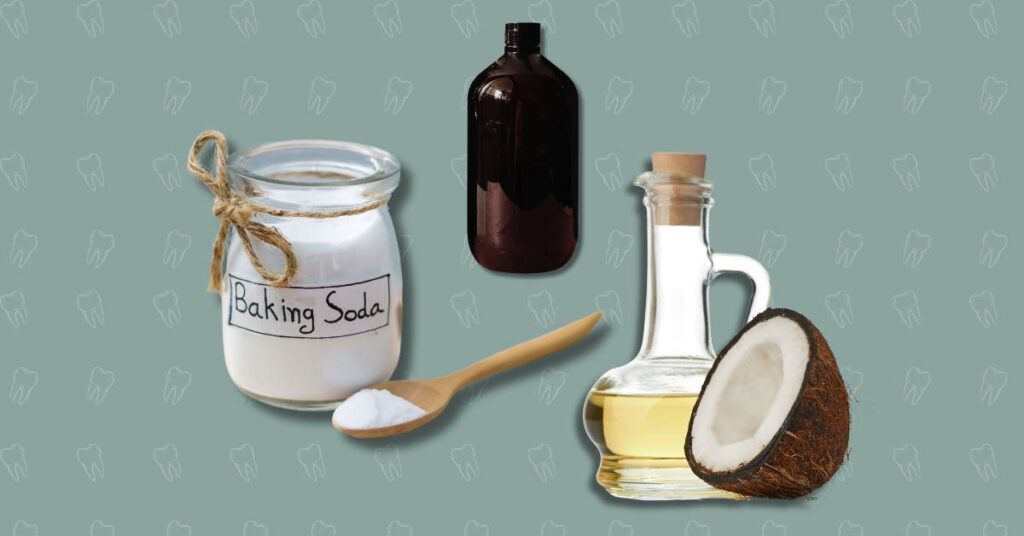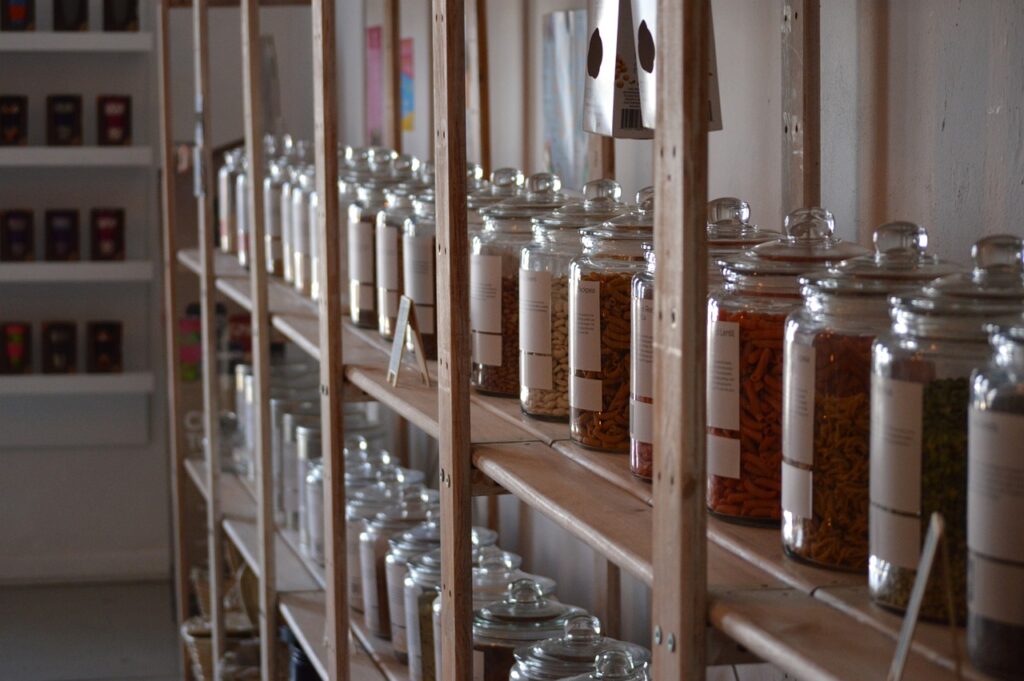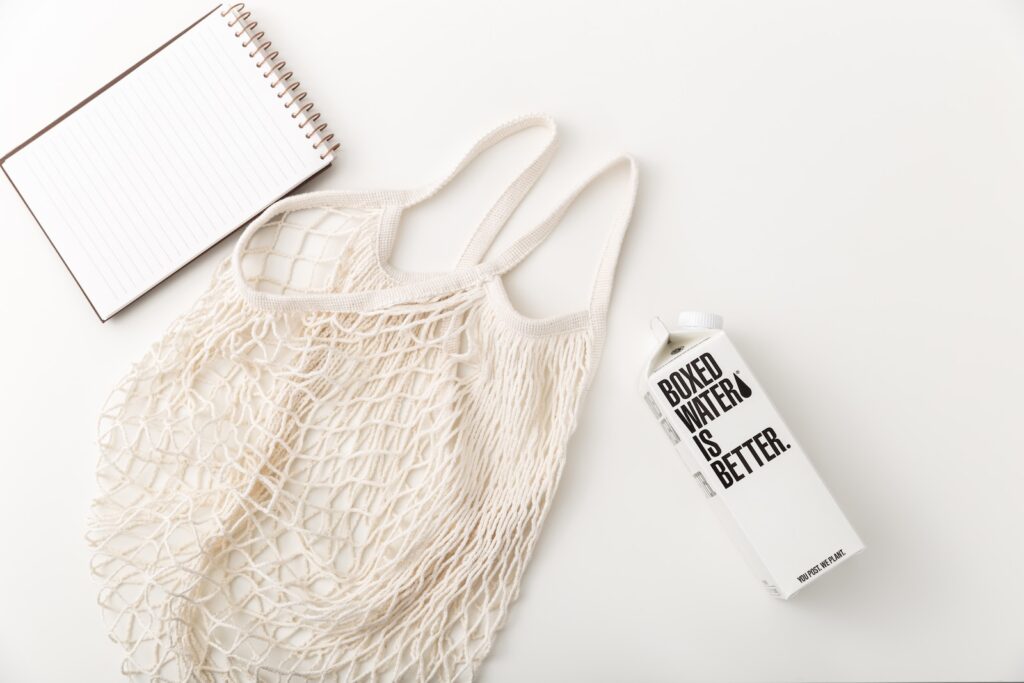We can all acknowledge that our fashion choices significantly affect our environment. As consumers become more environmentally conscious, the fabrics we choose become front and center in the discussion of sustainability.
In this post, you’ll dive deep into two prominent fabrics: Tencel (Lyocell) and polyester. You’ll unearth their origins, environmental footprints, comfort levels, and roles in fashion and home textiles.
We will compare the eco-credentials of Tencel vs. polyester, explore their distinct textures and styles, and assess their versatility across various applications. Armed with this knowledge, you’ll be empowered to make choices that resonate with both your fashion sense and environmental values.
Historical Context: The Origin Stories
Understanding the history of Tencel and polyester can provide a richer context to their current roles in the fashion industry.
Tencel (Lyocell):
Tencel, also known as Lyocell fabric, was developed in the 1980s as an environmentally friendly alternative to other synthetic fabrics. Its production process, which uses wood pulp from sustainable tree sources, was a groundbreaking approach to textile manufacturing. The Lenzing AG company owns the brand name Tencel and has manufactured lycoell for a long time. The first large-scale lyocell plant was opened by Lenzing in 1997.
Polyester:
Polyester, a synthetic fabric derived from petrochemicals, dates back to the 1940s. It was hailed as a wonder fabric due to its durability, wrinkle resistance, and affordability. Over the decades, its popularity soared, especially during the 1970s, when it became synonymous with disco fashion.
The main difference between the two fibers is that Tencel is made from wood, and polyester is made from petroleum.
Tencel (Lyocell): A Sustainable Marvel
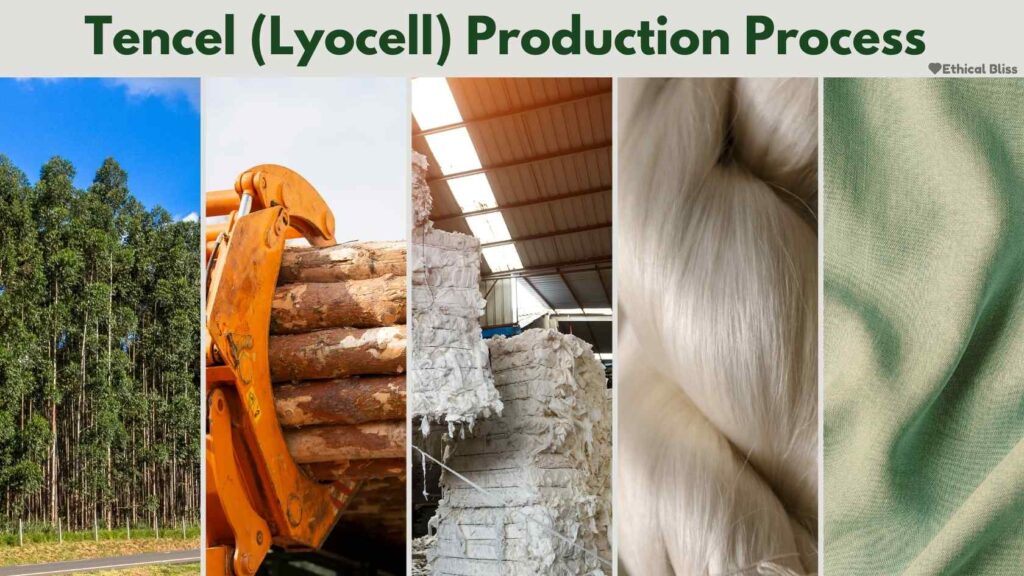

Let’s start with Tencel, also known as Lyocell, a fabric gaining popularity for its impressive eco-credentials. Tencel is a semi-synthetic fabric from wood pulp, typically sourced from eucalyptus, beech, or spruce trees. The wood cellulose fibers are extracted from the trees. These Tencel fibers form the basis of Tencel fabric.
Eucalyptus Trees and Sustainable Sourcing:
Eucalyptus trees are a primary source of wood pulp for Tencel production. They are known for their rapid growth, which makes them a sustainable and renewable resource. Tencel’s responsible sourcing of raw materials from these trees ensures minimal impact on forests.
The Closed-Loop Process:
One of the key aspects of Tencel’s sustainability is the closed-loop process used in its manufacturing. Unlike many other textiles, the closed loop process for Tencel minimizes waste and reduces the need for toxic chemicals. The process starts with wood pulped from trees, then dissolved in a chemical solvent (n-methylmorpholine n-oxide). This forms a thick solution that is then pushed through tiny holes to form individual thin fibers. They are then put in a water bath to remove the solvent, pressed and turned into fibers, and then fabric.
This manufacturing process of lyocell recycles nearly all solvents and water, making it a highly efficient and eco-friendly manufacturing process that minimizes harmful by-products. Tencel is referred to as a semi-synthetic fiber because of this process. Its main component is derived from natural materials that undergo a chemical process to create fibers.
Tencel’s Low Environmental Impact:
In terms of environmental impact, Tencel shines. It uses significantly less water than polyester, thanks to its closed-loop system. The production of Tencel also consumes less energy, resulting in a lower carbon footprint. These factors contribute to Tencel’s reputation as a sustainable fabric with a low environmental impact.
Polyester: The Synthetic Challenger
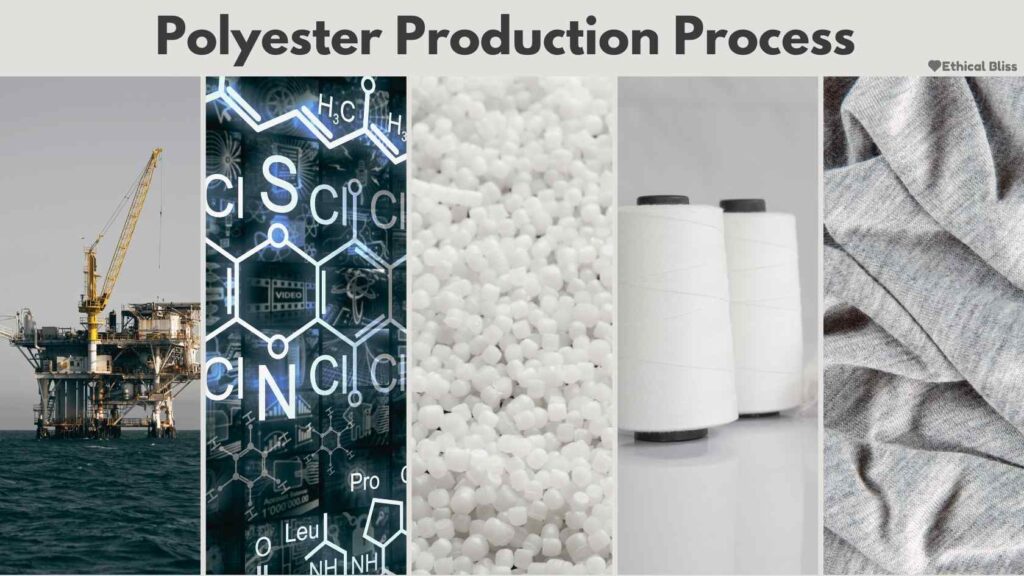

On the other side of the ring, we have polyester. This synthetic fabric has been a staple in the fashion industry for decades. Polyester is derived from petrochemicals, making it a purely artificial material. Specifically, it’s made from terephthalic acid and ethylene glycol (from crude oil) processed under high temperatures. It’s then turned into plastic pellets, fibers, and then fabric. It’s known for its durability and wrinkle resistance but comes with a significant environmental cost.
Synthetic Fibers and Their Impact:
Polyester is classified as a synthetic fiber, which means it’s entirely human-made through a chemical process. This process relies heavily on fossil fuels and energy-intensive manufacturing methods, contributing to a higher carbon footprint and more harmful by-products than natural or semi-synthetic fibers like Tencel.
Water Usage and Toxic Chemicals:
Polyester production also requires enormous amounts of water, particularly in the dyeing and finishing stages. Moreover, the dyeing process often involves toxic chemicals, posing environmental hazards.
Environmental Impact Comparison
Now, let’s compare the environmental impact of Tencel vs. polyester across various aspects:
Resource Use:
Tencel relies on sustainably sourced wood pulp and employs a closed-loop production process, while polyester relies on fossil fuels and energy-intensive processes. Advantage: Tencel.
Water Usage:
Thanks to its closed-loop system, tencel production uses significantly less water than polyester. Polyester requires large amounts of water for dyeing and finishing. Advantage: Tencel.
Energy Consumption:
The production of polyester is energy-intensive, while Tencel’s closed-loop system reduces energy consumption. Advantage: Tencel.
Biodegradability:
Tencel is biodegradable, breaking down naturally without harming the environment. Polyester, a synthetic fabric, does not biodegrade and contributes to plastic pollution. Advantage: Tencel.
Carbon Footprint:
Tencel’s closed-loop production and sustainable sourcing result in a significantly lower carbon footprint than the energy-intensive, petrochemical-based polyester production. Advantage: Tencel.
Fashion and Comfort
Aside from the environmental impact, let’s talk about comfort and style. Tencel is known for its silky smooth texture, breathability, and moisture-wicking properties. It’s perfect for those who prioritize comfort and want to stay cool in warm weather. Polyester, while durable, can be less breathable and comfortable, especially in hot and humid conditions.
Moisture-Wicking Properties:
Tencel’s moisture-wicking properties make it an excellent choice for activewear and clothing for hot sleepers. Its ability to draw moisture away from the body keeps you feeling dry and comfortable, even during intense physical activity or on sweltering summer days.
Sensitivity and Allergic Reactions:
Tencel can be a savior for individuals with sensitive skin or allergies. Its soft and smooth natural fibers are less likely to cause skin irritations or allergic reactions than polyester’s rougher texture.
Versatility and Durability of Tencel vs. Polyester
Both Tencel and polyester have their strengths in terms of versatility and durability. Tencel’s softness and moisture-wicking abilities make it an excellent choice for everyday wear and activewear. Polyester’s durability makes it suitable for items that require resilience against wear and tear, like outdoor gear and some athletic wear.
Bed Sheets and Bedding:
Regarding bedding, Tencel sheets (or lyocell sheets) have gained popularity for their luxurious feel and breathability. They are a great choice for those who want a comfortable night’s sleep, as Tencel’s natural temperature-regulating properties keep you cool in the summer and warm in the winter. Polyester sheets, while budget-friendly, may not offer the same level of comfort and breathability.
Care Instructions:
Tencel fabrics are relatively easy to care for. Most Tencel garments can be machine-washed in cold water and tumble-dried on low heat. On the other hand, polyester is known for its resistance to wrinkles and quick drying. Still, it can be less forgiving when it comes to stains and may require more careful handling in the laundry.
Economic Impact: Cost of Production and Consumer Pricing
The economic implications of producing Tencel and polyester vary significantly:
Tencel (Lyocell):
The production of Tencel, while more environmentally friendly, can be costlier due to its sustainable sourcing and closed-loop process. However, economies of scale might reduce production costs as demand for eco-friendly products rises.
Polyester:
Polyester, which is completely synthetic, is generally cheaper to produce, especially in large quantities. This cost-effectiveness often translates to lower prices for the end consumer, making it a staple in fast fashion.
Fashion Trend of Tencel vs. Polyester: The Rise and Fall of Fabrics
Fashion trends have played a pivotal role in the popularity of both Tencel and polyester:
Tencel (Lyocell):
With the modern consumer’s shift towards sustainable and eco-friendly products, Tencel has seen a surge in popularity. Its soft texture and eco-credentials make it a favorite for brands promoting sustainable fashion.
Polyester:
Polyester’s peak in popularity can be traced back to the 1970s. However, with the rise of fast fashion in the 2000s, its demand skyrocketed. Its durability and cost-effectiveness made it a go-to fabric for many fashion brands. However, its environmental concerns have pushed for more sustainable alternatives in recent years.
Environmental Initiatives: A Push for Sustainability
The textile industry has witnessed several initiatives aimed at promoting sustainability:
Tencel (Lyocell):
Tencel, the brand, is committed to obtaining “True Carbon Zero.” Their goal is to obtain net-zero emissions by 2050.
The brand continuously innovates to reduce its carbon footprint and promote a more sustainable textile industry. Tencel has been certified by a variety of global standards for sustainability, including the Forest Stewardship Council and the Programme for the Endorsement of Forest Certification. Tencel has also received the designation of Biopreffered by the USDA. The USDA Biopreferred program aims to increase the use and purchase of biobased goods and reduce the use and reliance on petroleum in goods. Thus reducing the negative environmental and health impacts of its use.
Polyester:
While polyester has been criticized for its environmental impact, efforts have been made to make it more sustainable. Recycled polyester, made from post-consumer plastic bottles, is one such initiative. Brands increasingly use recycled polyester to mitigate the environmental concerns associated with traditional polyester.
Recycling and End-of-Life Considerations: A Sustainable Afterlife
As the global push for sustainability intensifies, the end-of-life considerations for fabrics become crucial. Both Tencel and polyester have unique attributes when it comes to recycling and their eventual impact once they’ve served their purpose.
Tencel (Lyocell):
One of Tencel’s standout features is its biodegradability. Being derived from natural wood sources, garments made from Tencel can decompose naturally, returning to the environment without leaving harmful residues. This ensures that, at the end of its lifecycle, Tencel doesn’t contribute to the mounting problem of non-biodegradable waste. Moreover, initiatives are underway to develop methods to recycle Tencel products, further enhancing its eco-friendly credentials.
Polyester:
Polyester’s synthetic nature presents challenges when it comes to its end-of-life. Traditional polyester doesn’t biodegrade readily, which means discarded polyester garments can persist in landfills for centuries. However, there’s a silver lining. Advances in textile recycling technologies have made it possible to recycle polyester garments. Recycled polyester, often sourced from post-consumer plastic bottles, is now being used to produce new garments, reducing the need for virgin polyester production and offering a more sustainable alternative.
It’s worth noting that while recycling technologies offer hope, the onus is also on consumers to ensure their garments find their way to recycling facilities. By being mindful of how we dispose of our clothing, we can play a pivotal role in ensuring a sustainable afterlife for our garments, be it Tencel’s return to nature or polyester’s reincarnation in a new form.
Consumer Perception and Branding: Fabric Narratives in Modern Times
The fabrics we choose often reflect our values and beliefs. Tencel and polyester, each with its unique story, have evolved in the eyes of consumers, influenced by branding and sustainability trends.
Tencel (Lyocell):
Tencel is often branded as the eco-luxury choice. Its sustainable production and soft texture appeal to environmentally-conscious consumers seeking comfort. Brands using Tencel emphasize its green credentials, aligning with the rising demand for eco-friendly fashion.
Polyester:
Once lauded for durability and affordability, polyester’s narrative has shifted. With environmental concerns in the spotlight, brands now highlight recycled polyester as a sustainable alternative. This “recycled” tag aims to align polyester with modern eco-values.
The stories of both fabrics are shaped by industry marketing and evolving consumer preferences, reflecting the dynamic nature of fashion and sustainability.
Tencel Lyocell vs. Tencel Modal: Understanding the Difference
Tencel brand offers two primary types of fibers: Tencel Lyocell and Tencel Modal. While both fibers are derived from sustainably sourced natural raw material wood and are celebrated for their eco-friendliness, they possess distinct characteristics that cater to different needs in the textile industry.
Tencel Lyocell fibers:
Known for their natural comfort, Tencel Lyocell fibers stand out due to their versatility. They can be blended with a myriad of textile fibers, including cotton, polyester, acrylic, wool, and silk, enhancing the resulting fabric’s aesthetics and functionality. One of the unique attributes of Tencel Lyocell fibers is their impressive strength coupled with efficient moisture absorption, making them gentle on the skin.
Tencel Modal fibers:
These fibers are celebrated for their exquisite softness, providing a pleasant feel against the skin. Tencel Modal fibers are highly flexible, which allows them to enhance textiles with a naturally soft quality. This softness offers endless design possibilities, and when blended with other fibers, it significantly improves the comfort of the fabrics.
In essence, while both Tencel Lyocell and Tencel Modal fibers are rooted in sustainability and eco-conscious production, they cater to different textile needs. Lyocell is recognized for its strength and moisture management, making it ideal for a range of applications, from everyday wear to specialized garments. On the other hand, Modal is the go-to for those seeking unparalleled softness in their textiles, ensuring comfort and a luxurious feel.
Is Tencel Stretchy in Jeans?
Tencel is a versatile fabric that is often blended with other materials to achieve specific characteristics in clothing, including jeans. When it comes to being stretchy, Tencel in jeans itself is not inherently elastic. However, its smooth and soft fibers allow for a comfortable fit and a natural drape, which can give the feeling of a slight stretch when worn.
In the world of jeans, stretch is often a desired quality for both comfort and fit. To achieve this, Tencel is commonly blended with materials like elastane, spandex, or Lycra. These materials provide the elasticity, while Tencel contributes to the softness, breathability, and moisture-wicking properties of the jeans.
Furthermore, the weave of the fabric can also influence its stretchiness. For instance, a twill weave, commonly used in jeans, can offer a bit of natural give. When combined with the right blend of fibers, this can result in jeans that are both stretchy and comfortable.
So while Tencel in jeans itself isn’t stretchy, its combination with elastic fibers and specific weaves can make jeans that feel stretchy and incredibly comfortable. When shopping for Tencel jeans, it’s essential to check the fabric composition to understand the level of stretch and comfort you can expect.
Conclusion: The Sustainable Winner
In the ultimate Tencel vs. polyester fabric matchup, Tencel emerges as the clear sustainable winner. It outshines polyester in nearly every aspect, from its eco-friendly production process to its biodegradability and overall environmental impact. While polyester has uses, especially in durable applications, Tencel offers a more sustainable and eco-conscious choice for everyday clothing.
By opting for Tencel over polyester, you elevate your comfort and style and contribute to a greener, more sustainable fashion industry. Your choice matters, and choosing Tencel is a step towards a more ethical and eco-friendly wardrobe. So, the next time you shop for clothing or consider your bedding options, keep Tencel in mind and let your fashion choices reflect your commitment to a better, more sustainable future.
New on Ethical Bliss:
Best Natural Toothpaste Alternatives For Sparkling Teeth
Are you on the lookout for a more natural way to keep your smile bright and your…
A Bold Step to Improve Drinking Water Safety
The Biden-Harris Administration has taken a monumental step forward in the fight for cleaner, safer…
Are Tree-Free Bamboo Paper Towels Eco-Friendly & Panda-Safe?
Nothing beats the convenience of kitchen paper towels. They are a non-sustainable consumer good that…

